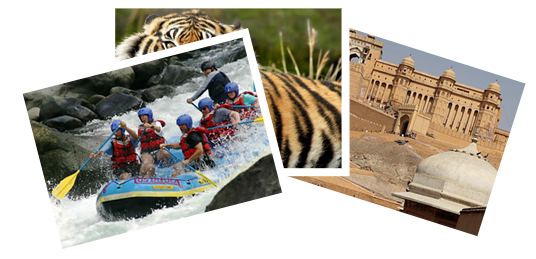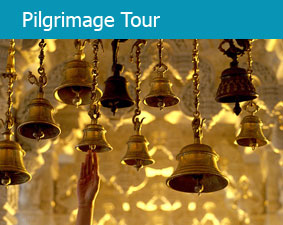| You are here: Home >> Pilgrimage Tour >> Char Dham Yatra | Back |
Char Dham Yatra
Tour Durations: 11 Nights / 12 Days
Destination Covered: Delhi - Haridwar - Barkot - Yamunotri - Uttarkashi - Gangotri - Guptkashi - Kedarnath - Rudraprayag - Badrinath - Joshimath - Rishikesh



Day 01: Delhi - Haridwar (230 Kms/ 07 Hrs approx.) 314 mts
On arrival at Delhi Airport / Delhi Railway Station, Meet & Assist by our Bliss India Holiday representative and further drive to Haridwar. On arrival check in hotel later visit Har-Ki-Pauri and attend the prayer ceremony (Aarti), later back to hotel for your overnight stay.
Day 02: Haridwar - Barkot (210kms/7 Hrs approx) 1352 mts
Char Dham Yatra from Haridwar - Morning Drive to Barkot via Mussoorie, Enroute visit Kempty Fall and others. Later drive straight to Barkot, transfer to your hotel and stay overnight.
Day 03: Barkot - Yamunotri - Barkot (36 Kms drive & 6 Kms Trek one side) 3235 mts
Early morning drive to Jankichatti/Phoolchatti, trek start from here to Yamuntori (6kms). Either by walk or by horse or by Doli at own cost. Arr. Yamuntori, One can cook rice by packing it in a cloth and dipping it in the hot water of the hot Kund. Pilgrims take this cooked rice home as "Prasad". Here near the temple "Pooja" can be offered to Divya Shila, after taking bath in Jamunabai Kund's warn water and having "Darshan" of pious "Yamunaji" returning to Jankichatti. Return back to Barkot, Overnight stay.
Yamuntori Temple: Maharani Gularia of Jaipur built the temple in the 19th Century. It was destroyed twice in the present century and rebuilt again.
Surya Kund: There are a Number of thermal springs in the vicinity of the temple, which flows into numerous pools. The most important of these is Surya Kund.
Divya Shila: A rock pillar, worshipped before entering the Yamunotri Temple.
Day 04: Barkot - Uttarkashi (100kms/4 Hrs.) 1352 mts
after breakfast drive to Uttarkashi on arrival visit Vishwanath Temple & Others. Check in Hotel and stay overnight.
Day 05 : Uttarkashi - Gangotri - Uttarkashi (100 Kms/3-4 each side) 3048 mts
Early morning drive to Gangotri, Enroute at Gangnani take a holy dip in Garam Kund, further drive to Gangotri via beautiful Harsil Valley. On arrival at Shree Gangotri, take a holy dip in the sacred river Ganges which is also called Bhagirathi at its origin. After performing Pooja and Darshan relax for some time in lovely surroundings, later return back to Uttarkashi and stay overnight.
Gangotri Temple: The temple, constructed by the Gorkha General Amar Singh Thapa in the 18th Century, situated on the right bank of Bhagirathi.
Submerged Shivling: Submerged in the river, this natural rock Shivling is the place where, according to mythology Lord Shiva sat when he received the Ganga in his matted lock. It is visible in winter months when water level decreases.
Kedar Ganga Sangam: Around 100 Yards from the Ganga Temple flows the river Kedar Ganga. Starting from the Kedar Valle, this river meets the Bhagirathi on its left bank.
Day 06: Uttarkashi – Guptkashi (220kms/8-9 Hrs.) 1319 mts
Drive straight to Guptkashi via Moolgarh & Lambgoan. On arrival check in at the Hotel, evening visit Ardh Narishwar Temple. Overnight stay at the Hotel. The name Gupt Kashi means "Hidden Benares. Mythology describes how when the Pandava brothers were searching for a glimpse of Shiva, Shivji first concealed himself at Gupt Kashi, but later fled from them further up the valley to Kedarnath, where the Pandavas finally got their wish fulfilled.
Day 07: Guptkashi - Kedarnath (30 Kms by road & 19kms Trek) 3384 mts
Morning drive to Gaurikund, Trek start from Gaurikund to Kedarnath (3584 mts) on foot or by Pony / Doli. Tour members should carry personal medicines, heavy woolen, toiletries and clothes for an overnight halt at Kedarnath. Check in Hotel. Later visit Kedarnath Temple and night halt.
The Kedarnath shrine, one of the 12 jyotirlingas of Lord Shiva, is a scenic spot situated, against the backdrop of the majestic Kedarnath range. Kedar is another name of Lord Shiva, the protector and the destroyer. According to legend, the Pandavas after having won over the Kaurava in the Kurukshetra war, felt guilty of having killed their own brothers and sought the blessings of Lord Shiva for redemption. He eluded them repeatedly and while fleeing took refuge at Kedarnath in the form of a bull. On being followed he dived into the ground, leaving his hump on the surface. The remaining portions of Lord Shiva appeared at four other places and are worshipped there as his manifestations. The arms appeared at Tungnath, the face at Rudranath, the belly at Madhmaheshwar and his locks (hair) with head at Kalpeshwar. Kedarnath and the four above-mentioned shrines are treated as Panch Kedar.
Early morning, after Temple Darshan trek down to Gaurikund. Later, drive to Rudraprayag via Guptkashi. Check in Hotel at Rudraprayag and stay overnight. Rudraprayag is one of the Panch Prayag (five confluences) of Alaknanda River, the point of confluence of rivers Alaknanda and Mandakini.
Day 09: Rudraprayag - Badrinath (160 Kms/7 Hrs.) 3133 mts
Badrinath Yatra - Drive to Badrinath via Joshimath. Check in Hotel. Later at evening visit Badrinath Temple for Aarti. Overnight stay. Badrinath one of the 'Four Dhams' is one of the most celebrated pilgrimage spots of the country and is situated at an elevation of 3,133 meters, guarded on either side by the two mountain ranges known as Nar & Narayan with the towering Neelkanth Peak providing a splendid backdrop. This revered spot was once carpeted with wild berries. Thus the place got the name "Badri van", meaning "forest of berries".
Tapt Kund: Natural thermal springs on the bank of the river Alaknanda, where it is customary to bathe before entering the Badrinath temple.
Narad Kund: A recess in the river, near Tapt Kund, forming a pool from where the Badrinath idol was recovered.
Brahama Kapal: A flat platform on the bank of river Alaknanda. Hindus perform proppitiating rites for their deceased ancestors.
Sheshnetra : 1.5kms. away is a boulder having an impression of the legendary serpent, better known as the Sheshnag's eye.
Charanpaduka: 3kms. away is a beautiful meadow where the footprint of Lord Vishnu is seen on a boulder.
Mata Murty Temple : Devoted to the mother of Sri Badrinathji. Other important temples include Sesh Netra Temple, Urvashi Temple and Charanpaduka.
Mana Village : Inhabited by an Indo-Mongolian tribe, it is the last Indian village before Tibet.
Vasundhara: As the name suggests, vasundhara is a magnificent water fall. This place is 5 kms. from Badrinath out of which 2 kms. is motorable upto Mana.
Bhim Pul: On the other side of Mana village, a massive rock forming a natural bridge, lies over the roaring Saraswati river. It presents a spectacular view of water thundering down through the narrow passage under the rock and is believed to have been placed there by Bhim, the second eldest among the five Pandava brothers.
Vyas Gufa (cave) : Near Mana Village, this is a rock-cave where Ved Vyas is believed to have composed the Mahabharata and the pauranic commentaries.
Day 10 : Badrinath – Joshimath - Rudraprayag (160kms/7 Hrs.) 895 mts
Early morning after having a bath in the Taptkund have the Darshan of Badrivishal. Brahamakapal is significant for Pind dan Shradha of ancestors (Pitrus). There are other interesting sightseeing spot like Mana, Vyas Gufa, Maatamoorti, Charanpaduka, Bhimkund and the "Mukh" of the Saraswati River. Just within the three kms of Badrinathjee. Later drive back to Rudraprayag via Joshimath. Check in Hotel and stay overnight at Joshimath, situated on the slopes above the confluence of the rivers Alaknanda and Dhauliganga. Of the four 'Maths' established by Adi Shankaracharya, Joshimath is the winter seat of Badrinath. The idol is brought down to Joshimath and installed in the temple for people to worship. There are many other temples in the township. The most important is the temple of Nir Singh with the idol of Lord Vishnu. The left arm of this deity is getting destroyed with time and the popular belief holds that the day the arm completely withers Badrinath valley will cease to exist and the Gods will transfer the residence into the neighboring Niti Valley at Bhavishya Badri.
Day 11 : Rudraprayag – Rishikesh (140 Kms/4 Hrs.)
Drive to Rishikesh, the 'place of sages' is a celebrated spiritual town on the bank of Ganga and is surrounded by Shivalik range of the Himalayas on three sides. It is said that when Raibhya Rishi did hard penances, God appeared by the name of " Hrishikesh " and this area hence came to be known as Rishikesh. Check in Hotel. Later visit Rishikesh Temples & Sight Seeing – Laxman Jhulla, Ram Jhulla, Triveni Ghat, Bharat Mandir, Shivananda Ashram. At evening visit Ganga Aarti at Parmarth Ashram. Overnight stay.
Day 12 : Rishikesh - Haridwar - Delhi (250kms/7-8 Hrs)
After breakfast drive to Delhi for further journey back to home with illustrious memory and
blessings of Chardham Tour






 Hi Anil,
Hi Anil,

